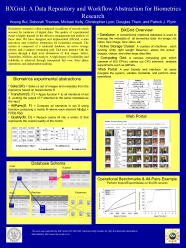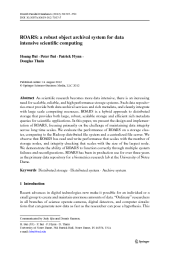BXGrid: Biometrics Research Grid
 bxgrid.cse.nd.edu
bxgrid.cse.nd.edu
BXGrid is an online repository and experimental management system for biometrics
research at Notre Dame. With a few clicks, a user can browse and process hundreds
of thousands of images and movies of irises, faces, and other biometric data, and
dispatch large scale experiments to our Condor pool.
This project is a collaboration between the Computer Vision Research Lab
and the Cooperative Computing Lab at Notre Dame.
BXGrid uses relational database to manage biometrics properties of a recording (image or movie). Metadata:
recording id, subject id, facial expression, camera sensor equiment, lightning condition... are sotred using
a strong schema. Using database to manage metadata of a large number of images and videos makes searching
much easier.
BXGrid utilizes an array of Active Storage Cluster to store biometrics data: images and movies.
BXGrid backend storage system includes 42 Chirp servers. Biometrics data is
replicated throughout BXGrid storage servers. BXGrid maintains three copies of each images or movies in three diffrent
Chirp servers. Location of each replica is store in BXGrid database. Other informations regrading a recording such as
size and checksum are also kept. These informations are used in aiding audit and repair process.
BXGrid is connected to a Computing Grid. BXGrid makes use of Condor pool at
Notre Dame. Condor pool provides BXGrid much needed computational power. BXGrid helps biometrics researchers conduct a wide
range of experiment, for example: to evaluate an iris comparison algorithm on 60,000 irises.
User interacts with BXGrid using a web portal.
User can navigate the system, browsing irises and faces, validating metadata, creating datasets and sharing datasets
with each other. The web portal is only accessible within Notre Dame campus network.
BXGrid was the feature story in an issue of International Science Grid This Week.
Publications
(Showing papers with tag bxgrid. See all papers instead.)

|
Christopher Moretti, Hoang Bui, Karen Hollingsworth, Brandon Rich, Patrick Flynn, and Douglas Thain,
All-Pairs: An Abstraction for Data Intensive Computing on Campus Grids,
IEEE Transactions on Parallel and Distributed Systems, 21(1), pages 33-46, January, 2010. DOI: 10.1109/TPDS.2009.49
|

|
Hoang Bui, Michael Kelly, Christopher Lyon, Mark Pasquier, Deborah Thomas, Patrick Flynn, and Douglas Thain,
Experience with BXGrid: A Data Repository and Computing Grid for Biometrics Research,
Journal of Cluster Computing, 12(4), pages 373, April, 2009. DOI: 10.1007/s10586-009-0098-7
|

|
Hoang Bui, Deborah Thomas, Michael Kelly, Christopher Lyon, Douglas Thain, and Patrick J. Flynn,
Poster: BXGrid: A Data Repository and Workflow Abstraction for Biometrics Research,
IEEE International Conference on e-Science, pages 394-395, December, 2008. DOI: 10.1109/eScience.2008.135
|
BXGrid Documentation

|
This research was supported by the National Science Foundation under
grant 0621434
|










 bxgrid.cse.nd.edu
bxgrid.cse.nd.edu
